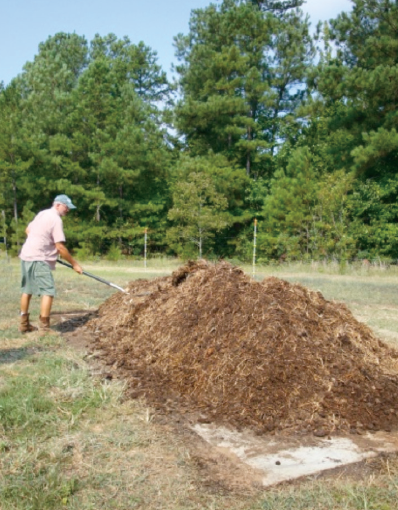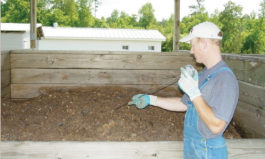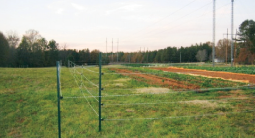Enhancing The Safety of Locally Grown Produce: Use of Manure and Other Soil Amendments of Animal Origin
ID
FST-39NP (FST-336NP)
Although manure is a valuable source of nutrients, it is also one of the greatest potential sources of pathogens that can cause foodborne illnesses. These pathogens can be found in the feces of humans, pets, farm animals and wild animals. Manure can contain harmful bacteria such as E. coli O157:H7, Salmonella spp., Campylobacter spp. and Listeria monocytogenes as well as viruses and parasites. Pathogens can survive in manure slurries or in the soil for three months or more. Human manure, raw or composted, should never be used on food crops because of the increased risk of contamination with harmful microorganisms that cause diseases in humans, heavy metals and other contaminants. The Produce Safety Rule prohibits the use of untreated human manure on crops unless it meets the EPA regulation for biosolids. More information can be found in the Code of Federal Regulations Section 40, Part 503. Many produce buyers may not accept produce grown in this manner.
In addition to raw manure, there are other soil amendments that must be considered “untreated” unless they have undergone a scientifically validated process to eliminate pathogens. These include manure that is only aged or stacked, bone meal, blood meal, feather meal, fish emulsion, manure slurries, manure teas, mixtures of other amendments with raw manure and any agricultural tea that has supplemental nutrients like molasses added to it to encourage microbial growth.
For farms that use raw manure or other untreated compounds of animal origin, precautions must be taken to prevent contamination of crops. The National Organic Program recommends a 90 day interval between application of raw manure and harvest of crops that grow above the soil and a 120 day waiting period if the crop is one that grows in or on the soil to allow for pathogen die-off. FDA is continuing to evaluate additional research to determine appropriate application intervals for raw manure. Check www.fda.gov periodically for the latest information on the Produce Safety Rule. The following steps will help you reduce potential contamination from other types of manure.
Composting
Proper composting of manure and other animal by-products (such as bone meal, feathers, etc.) kills pathogens. For this to happen, composting must be performed as a carefully controlled process. The internal temperature of the compost pile must reach between 131°F and 170°F and be maintained at these temperatures for specific lengths of time. These time/temperature guidelines are recognized by the U.S. Department of Agriculture, the U.S. Food and Drug Administration and the U.S. Environmental Protection Agency as effective for killing pathogens. When manure is composted by one of these methods, it can be used in the growing area without a waiting period between application and harvest of a crop. If you are using table waste, it must also go through this composting process because of the possibility that it has been in contact with saliva and may contain human pathogens. When these composting methods are used, then the resulting compost can be applied to crops without a waiting period between application and harvest, but should still be applied so that it is unlikely to contact the harvestable part of the plant.

- If composting in a vessel or an aerated static pile, these temperatures have to be maintained for at least three days followed by a managed curing process. If using a windrow or a pile that is not aerated, these temperatures have to be maintained for 15 days, and the pile has to be turned at least five times. Turning helps any material that would be on the exterior of the pile where temperatures are lower allowing pathogens to survive to be mixed into the interior during the composting process. Record temperatures and the date and then record again when the pile is turned.
- For small scale composting, make sure the beginning pile is at least 5 x 5 x 5 feet. Smaller piles do not generally have enough mass to retain heat and reach the needed temperatures. A proper mix of materials with a carbon to nitrogen ratio of about 25:1 will help the pile heat up quickly.

- Use a thermometer to make sure the proper temperatures are reached, and keep a record of the temperatures. Compost thermometers with varying stem lengths can be purchased at gardening supply stores and on-line.
- Be sure the compost pile is located away from growing areas and where leachate or runoff from the pile does not reach growing areas.
- If buying compost that contains manure, ask for records to show the compost was produced according to the standards cited here and keep these in your records.
Raw manure use
Raw manure can be used with certain precautions:

- Use raw manure to build fertility before planting with cover crops or crops that do not touch the soil.
- Do not topdress fruit and vegetable crops with raw manure.
- Incorporate manure into the soil.
- Wait at least 90 days before harvesting any crop where the harvestable portion does not come in contact with the soil after incorporation of raw manure, such as tomatoes, peppers, okra, etc.
- Wait at least 120 days before harvesting if using raw manure with crops where the harvestable portion comes in contact with the soil, such as potatoes, carrots, beets, lettuce, etc.
- Store raw manure away from growing areas.
- Prevent runoff from manure piles from reaching growing areas.
- Aged or stacked manure that has not been properly composted by the methods listed previously must be considered to be raw manure.
- Avoid tracking raw manure into active growing areas with machinery or boots.
Reducing contact of produce with animal feces
Wild animals are a part of farming and can play an important part in predator/prey relationships that can control some pests, but they can also bring pathogens into growing areas. Taking steps to keep wild animals out or discouraging their movement into growing areas, particularly near harvest time, and into water sources will reduce potential contamination from animal feces.

- Use fencing, netting, motion detectors connected to sprinklers or lights that frighten animals, decoys or other methods to deter animals from growing areas.
- Check for signs of wildlife activity and do not harvest produce if it is visibly contaminated with feces. If animal manure is present in an area, flagging the area and creating a no-harvest buffer zone around the area may be one method to prevent your produce from being contaminated during harvest.
Domestic animals are also a potential source of pathogens, whether they are livestock, working animals, poultry or pets like dogs and cats.
- Exclude poultry, pigs and other domestic livestock from growing areas.
- If using working animals in growing areas, create pathways for the animals to travel in order to minimize opportunities for contamination.
- If using a chicken tractor for fertility and pest control or pigs for weed control, till the growing area to incorporate any manure and observe the proper 90 or 120 day waiting period before harvest, as appropriate for the crop.
- Exclude dogs and cats from the growing area. These animals can carry parasites and pathogens that infect humans.
Cross-contamination of raw manure and composted manure
Prevent cross-contamination of properly composted manure with raw manure.
- Be sure that you protect a finished compost pile from contamination sources such as runoff from an unfinished compost pile or domesticated and wild animals.
- Keep tools and equipment used to work with or transport raw manure separate from tools and equipment used with composted manure, or
- Thoroughly clean and sanitize these before use with composted manure.
- Be sure work boots, gloves and clothing are also cleaned after working with raw manure. Boots and gloves can be cleaned by scrubbing with a solution of 1 oz. powdered laundry detergent in one gallon of water and rinsing with a garden hose, followed by sanitizing.
- Sanitize using a solution of chlorine bleach and water. If plain, unscented household chlorine bleach that is 5-6% sodium hypochlorite is used, add 2 tablespoons chlorine bleach per gallon of water. If concentrated bleach (8.25% sodium hypochlorite) is used, use 2 teaspoons per gallon of water. This solution can be applied by spraying or by immersion for 5 minutes. Allow to air-dry. Chlorine bleach and water sanitizing solutions degrade with time and with exposure to sunlight or heat. Therefore, sanitizing solutions should be made daily.
This project was supported all, or in part, by a grant from the National Institute of Food and Agriculture, United States Department of Agriculture (Award Number 2009-51110-20161) and the Food Safety Outreach Program [grant no. 2016 0020-25888/project accession no. 1010671] from the USDA National Institute of Food and Agriculture.
Publication #FDNS-E-168-5, 2nd Edition. J.W. Gaskin, J.A. Harrison, M.A. Harrison, J. Cannon, R. Boyer, G. Zehnder and K. Woods.
The University of Georgia and Ft. Valley State University, the U.S. Department of Agriculture and counties of the state cooperating. Cooperative Extension, the University of Georgia Colleges of Agricultural and Environmental Sciences and Family and Consumer Sciences, offers educational programs, assistance and materials to all people without regard to race, color, national origin, age, gender or disability. An Equal Opportunity Employer/Affirmative Action Organization, Committed to a Diverse Work Force.

Virginia Cooperative Extension materials are available for public use, reprint, or citation without further permission, provided the use includes credit to the author and to Virginia Cooperative Extension, Virginia Tech, and Virginia State University.
Virginia Cooperative Extension is a partnership of Virginia Tech, Virginia State University, the U.S. Department of Agriculture, and local governments. Its programs and employment are open to all, regardless of age, color, disability, sex (including pregnancy), gender, gender identity, gender expression, genetic information, ethnicity or national origin, political affiliation, race, religion, sexual orientation, or military status, or any other basis protected by law.
Publication Date
January 15, 2025



